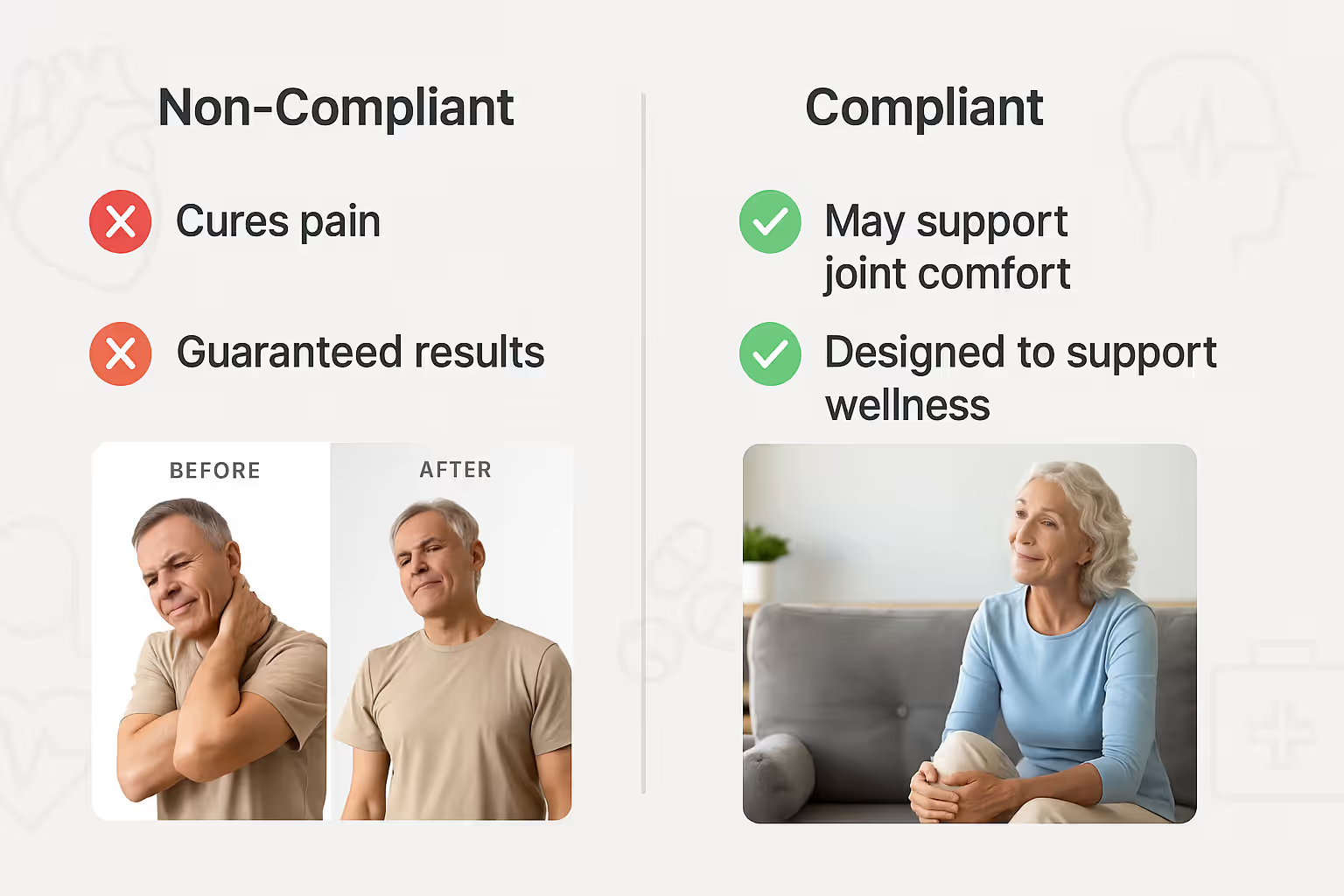How to Create Effective Ads for Health Products: Compliant & High-Converting Strategies
.avif)
Marketing health products with ads requires more than catchy slogans and visuals. It’s about earning trust while staying compliant. In a space where regulations are strict and consumer expectations are high, brands must balance persuasive storytelling with accuracy and credibility.
Whether you’re selling health supplements online, skincare products, or fitness formulas, learning how to create effective ads for health products helps you stand out in a competitive market.
In this guide, we’ll explore examples of health product advertisements that work, break down compliance-friendly ad practices, and share tips to help your brand build campaigns that convert, safely and effectively.
6 Examples of Health Product Advertisements That Work
Let’s start with real-world examples of health product advertisements.
These show how brands blend persuasion, compliance, and creativity to connect with their audiences.
So if you are just starting out and want to sell your own digestive health supplements, or products boosting health in any other way, dive in with us and explore some of the best success stories in health product advertising.
1. Bloom Nutrition – “30-Day Glow-Up” Facebook Ad

- Ad Type: Facebook carousel
- Visuals: Bright, cheerful color blocking paired with bold text reading “30-Day Glow-Up.” A friendly customer quote adds warmth and credibility.
- Copy Angle: Simple, confident, and instantly clear about the product’s promise.
- Why It Works:
- The message tells you exactly what the ad is about in seconds.
- The approachable tone and customer testimonial make it relatable.
- Balanced color use and clean typography convey energy and trust.
- Takeaway: Advertisements that are this straightforward and visually clear are the ones that stay with you and make your wellness products best-selling.
2. AG1 – “Scoop and Sip” Instagram Ad

- Ad Type: Instagram post
- Visuals: A single scoop of powder, a clean glass, and a minimal background, nothing else competing for attention.
- Copy Angle: Effortlessly simple and visually calming.
- Why It Works:
- Minimalism at its best, but with a twist. The format mimics recipe-style posts you often see on social media.
- The “recipe” being just AG1 makes it clever and instantly recognizable.
- It blends lifestyle content with subtle product placement, avoiding the cluttered feel that many health product ads fall into.
- Takeaway: You don’t always need text-heavy ads. Sometimes, a clean visual concept can speak volumes when the product fits naturally into everyday life.
3. Metagenics – “Learn More” Carousel Ad

- Ad Type: Carousel banner
- Visuals: A simple background, bright product focus, and concise copy that gets to the point. The clean layout draws attention directly to the supplement without distractions.
- Copy Angle: Minimal, confident, and informative. The design lets the visuals do most of the talking.
- Why It Works:
- Built entirely on the principle of minimalism.
- The use of the brand’s signature colors builds instant recognition and trust.
- Carousel ads naturally drive high engagement. They are perfect for health brands that want to highlight multiple product benefits at one glance.
- Takeaway: Knowing how to sell health products to your audience in ads means understanding your ad doesn’t have to be loud. Sometimes, simplicity, balance, and thoughtful color use create a stronger emotional connection than heavy messaging.
4. Supergoop! – “Summer in a Bottle” Campaign Ad

- Ad Type: Facebook image ad
- Visuals: A bright sky-blue backdrop with the sunscreen bottle front and center. The colors radiate warmth and instantly evoke the feeling of summer.
- Copy Angle: Short and sensory. “Summer in a bottle” does all the work.
- Why It Works:
- The color palette alone transports the viewer somewhere sunny and carefree.
- It makes SPF feel like a fun ritual rather than a chore, a clever emotional reframe for a health-related product.
- The ad feels indulgent and lighthearted, proving that wellness advertising doesn’t have to look clinical.
- Takeaway: When a brand can turn a routine product like sunscreen into an experience, that’s great marketing.
5. Grüns – “Keep It Real” Ad

- Ad Type: Instagram video ad
- Visuals: Playful graphics and casual text paired with a cheeky tagline that instantly grabs attention. The visuals are bright but not overdone, giving off a fun, approachable vibe.
- Copy Angle: Humorous, self-aware, and refreshingly honest - a break from the overly polished aesthetic common in wellness marketing.
- Why It Works:
- You read it, you laugh, and you immediately want to know more.
- Humor makes the brand feel human and relatable, especially in a space that often feels too serious.
- It delivers a clear message while entertaining - a rare balance in health product ads.
- Takeaway: Health and wellness advertising doesn’t have to be all green juice and perfection. A little humor can build stronger emotional connections than a thousand product claims.
6. SuperMush – “Instead of This / Try This” Split-Screen Ad

- Ad Type: Instagram carousel
- Visuals: Split-screen design featuring “Instead of this / Try this” messaging in playful retro fonts and bright, eye-catching colors. Each panel contrasts familiar unhealthy habits with SuperMush’s healthier alternative.
- Copy Angle: Short, punchy, and instantly clear. It feels more like a fun lifestyle post than a sales pitch.
- Why It Works:
- Split-screen comparisons can feel overused, but this one nails the balance between creativity and clarity.
- The vintage-style typography and bold colors make it scroll-stopping without being overwhelming.
- It sparks curiosity - you get the message instantly, but still want to learn more about the product.
- Takeaway: Health product advertisements don’t have to sound preachy. When done right, simple visuals and clever copy can make curiosity do the selling.
Crafting Compliant Ad Copy
Once you’ve seen what works, it’s time to learn how to write ad copy that passes platform checks and earns audience trust.
Health product advertising requires careful language choices:
- Focus on supporting wellness rather than treating conditions.
- Use cautious terms like “may help” or “designed to support.”
- Emphasize ingredients and their known benefits.
- Avoid before/after imagery that implies guaranteed results.
- Always include necessary disclaimers, such as:
“These statements have not been evaluated by the FDA.”

This approach makes your ad credible, compliant, and consumer-friendly.
Creating Compelling Visual Assets
Visuals are often the first thing people notice, and in health product advertising, they carry extra weight.

Here’s how to create visuals that resonate while staying within ad policies:
- Show lifestyle benefits rather than medical results.
- Feature diverse models who represent your audience.
- Highlight product packaging and ingredient quality.
- Use color psychology. Soft greens and blues evoke health and calm.
- Include trust signals, like certifications or FDA disclaimers, directly in imagery.
When advertising health products, authenticity always wins. Use visuals that reflect real life: active, happy, healthy people, not unrealistic transformations.
Targeting Strategies for Health Product Ads
Even the best ad won’t perform without the right audience. Effective ads balance reach with relevance.
Demographic Targeting
Think beyond age and gender. Consider:
- Life stages (new parents, active seniors)
- Occupation (healthcare workers, fitness enthusiasts)
- Education level (especially for advertising supplements that are complex)
Interest-Based Targeting
Focus on people interested in:
- Wellness habits (yoga, meditation, running)
- Nutrition and healthy living content
- Related products (organic food, gym gear)
Lookalike Audiences
Once you have data from past customers, build lookalike audiences using:
- Website visitors
- Email subscribers
- Repeat buyers
These audience layers help ensure your ad reaches genuinely interested users, not random scrollers.
Platform-Specific Ad Tips (Google, Facebook, TikTok)
Each platform has its own rules, strengths, and ad opportunities. Here’s how to tailor your campaigns:
Google Ads
- Avoid condition-specific keywords like “anxiety cure.” Instead, use “supplements that may support calmness.”
- Create informative landing pages that back up claims.
- Use Google Shopping ads to highlight verified reviews and transparent labeling.
Facebook & Instagram Ads
- Showcase lifestyle integration, not medical outcomes.
- Use carousel or story formats to explain ingredients and benefits.
- Leverage user-generated content or testimonials that feel natural.
TikTok Ads
- Focus on authentic, creator-driven videos.
- Use Tiktok trends or routines to highlight how your product fits into daily life.
- Keep it short, engaging, and educational.
No matter the platform, promoting products effectively means aligning creativity with compliance.
Tips to Make Your Advertisement About Health Products Stand Out
Here’s how to make your campaign memorable and trustworthy:
- Keep claims honest and verifiable.
- Use short, relatable headlines like “Support your wellness, naturally.”
- Add social proof (reviews, certifications).
- Stay consistent with your brand’s tone and visuals.
- Educate, don’t exaggerate.
- Test visuals and messages regularly to see what resonates.
Remember: the best advertisement for a health product educates and builds confidence.
Build Trust Through Compliant, Effective Ads
Creating ads that perform well isn’t just about targeting or design. It’s about earning trust through compliance and authenticity.
Study successful examples of health product advertisements, craft copy that educates, and follow platform guidelines carefully. By doing so, your brand can reach more people, build lasting credibility, and grow sustainably.
Supliful can help you bring your health brand to life. From product formulation to fulfillment, it’s your one-stop platform for launching private-label supplements. You focus on the branding, we’ll handle the rest.
FAQ
Related blogs

Influencer Pricing Calculator: Find Your Fair Rate for Posts, Reels & Stories
.avif)
How To Market Pet Products Through Storytelling: Win Attention, Build Trust, and Boost Sales Naturally
.avif)
How To Market Coffee To Gen Z: The High-Impact Blueprint Every Brand Needs
.avif)

